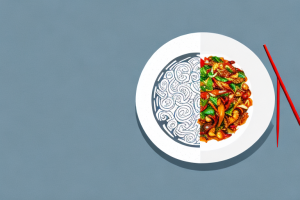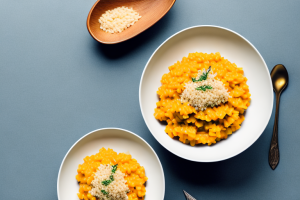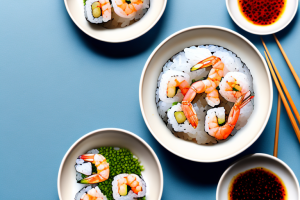How to cook basmati rice with butter and herbs
8 min read
A pot of cooked basmati rice with herbs and butter
Basmati rice is a long-grain rice variety from the Indian subcontinent. It is known for its unique aroma and flavor that can be enhanced by adding butter and herbs. In this article, we will guide you on how to cook basmati rice with butter and herbs to create a delicious, fragrant and healthy dish.
Why Basmati Rice is a great choice for cooking
Basmati rice is a great choice for cooking because of its long and slender grain that remains separate and fluffy after cooking, making it ideal for rice dishes and pilafs. Additionally, it has a unique aroma and flavor that is distinct from other rice varieties. Basmati rice is also gluten-free and low in fat, making it a healthy option for people who want to enjoy a flavorful meal without worrying about their calorie intake.
Another reason why Basmati rice is a great choice for cooking is that it is versatile and can be used in a variety of dishes. It can be paired with different spices and ingredients to create a range of flavors and textures. Basmati rice can be used in savory dishes like biryanis, curries, and stir-fries, as well as in sweet dishes like rice pudding and kheer.
Furthermore, Basmati rice is a staple in many cuisines around the world, including Indian, Pakistani, and Middle Eastern cuisine. It has been cultivated for centuries and is known for its quality and taste. When cooked properly, Basmati rice can elevate any dish and add a touch of sophistication to your meal.
The best types of herbs to use in your Basmati rice recipe
Adding fresh herbs to your basmati rice recipe is a great way to enhance its flavor and aroma. Some of the best herbs to use in your basmati rice recipe include fresh parsley, cilantro, thyme, and rosemary. These herbs will not only add flavor to your dish, but also provide additional health benefits as they contain antioxidants and other important nutrients that can boost your immune system and improve digestion.
Another great herb to use in your basmati rice recipe is fresh mint. Mint has a refreshing and cooling effect on the palate, making it a perfect addition to spicy or savory dishes. It also has anti-inflammatory properties that can help soothe digestive issues and relieve nausea.
If you’re looking for a more subtle flavor, you can try using dried herbs like bay leaves, oregano, or thyme. These herbs have a more concentrated flavor and aroma, so a little goes a long way. They also have antibacterial and antifungal properties that can help prevent food spoilage and promote overall health.
Health benefits of adding butter to your rice
Adding butter to your basmati rice not only makes it more flavorful and moist, but also provides a host of health benefits. Butter is a rich source of fat-soluble vitamins such as vitamin A, D, E and K, which are important for maintaining healthy skin, bones and immune system. Butter also contains conjugated linoleic acid (CLA), which has been shown to reduce inflammation, lower cholesterol levels, and protect against certain types of cancer. However, it is important to consume butter in moderation as it is high in calories and saturated fat, which can lead to weight gain and other health problems if consumed in excess.
Additionally, butter contains butyrate, a type of fatty acid that has been linked to improved gut health. Butyrate is produced by the bacteria in our gut when they ferment dietary fiber, and it helps to nourish the cells lining our digestive tract, reducing inflammation and promoting healthy digestion. By adding butter to your rice, you can increase your intake of butyrate and support a healthy gut microbiome.
How to properly cook Basmati rice for the perfect texture
Cooking basmati rice to the perfect texture requires a little bit of know-how. Before cooking, it is important to rinse the rice thoroughly to remove excess starch and debris. Then, add the rice to a pot with water at a ratio of 1:2 (one cup of rice to two cups of water). Bring the pot to a boil, then lower the heat to a simmer, cover the pot with a tight-fitting lid and let the rice cook for 15-20 minutes until all the water has been absorbed. Once the rice is cooked, fluff it with a fork to separate the grains and serve immediately.
It is important to note that the quality of the rice also plays a significant role in achieving the perfect texture. Always choose high-quality, aged basmati rice for the best results. Additionally, if you want to add some flavor to your rice, you can add a cinnamon stick, cardamom pods, or bay leaves to the pot while cooking. This will infuse the rice with a subtle, aromatic flavor that pairs well with many dishes.
Spicing up your Basmati rice with additional ingredients
If you want to add more flavor and depth to your basmati rice dish, you can incorporate other ingredients such as onions, garlic, ginger, or vegetables such as peas, carrots, and bell peppers. These ingredients will not only enhance the flavor of your dish but also provide additional nutrients and fiber to your meal. You can also add spices such as cumin, coriander, turmeric, and garam masala to give your dish an added kick.
Another way to add more flavor to your basmati rice is by using broth instead of water when cooking. This will infuse the rice with additional flavor and make it more savory. You can also add nuts such as almonds, cashews, or pistachios to your dish for added texture and flavor.
If you want to make your basmati rice dish more filling, you can add protein such as chicken, beef, or tofu. This will not only make your dish more satisfying but also provide you with the necessary protein to keep you energized throughout the day. You can also add herbs such as cilantro or parsley to give your dish a fresh and vibrant taste.
Simple tips for preparing and measuring your ingredients
Preparing and measuring your ingredients correctly is essential to the success of your basmati rice dish. Make sure you measure the rice and water properly, using a measuring cup or scale to avoid any guesswork. Rinse the rice thoroughly to remove any excess starch and debris before cooking. When adding spices or herbs, it is important to start with a small amount and then adjust according to your taste preference.
Using a rice cooker versus stovetop cooking methods
You can cook basmati rice on the stovetop or using a rice cooker depending on your preference. Using a rice cooker is more convenient as it allows you to set the cooking time and forget about it, while cooking on the stove requires more attention and monitoring. However, cooking on the stove allows for better control over the heat and texture of the rice. Both methods can yield delicious and fluffy basmati rice.
How long should you cook your Basmati rice?
The cooking time for basmati rice varies depending on the method of cooking used and the amount of rice being cooked. As a general rule of thumb, basmati rice should be cooked for 15-20 minutes on the stovetop or in a rice cooker until all the water has been absorbed and the grains are tender but still firm. Always check the cooking instructions on the package of the rice you are using for more specific cooking times and directions.
Adding flavor and aroma to your Basmati rice with herbs and spices
Adding herbs and spices to your basmati rice dish is a great way to infuse it with flavor and aroma. Some of the best herbs and spices to use in your basmati rice include cumin, coriander, turmeric, garam masala, rosemary, and thyme. These ingredients can be added to the pot with the rice and water or sautéed with onions and garlic before adding the rice. Experiment with different herbs and spices to find the perfect combination for your taste buds.
Serving suggestions and pairing options for your delicious Basmati rice dish
Basmati rice with butter and herbs goes well with a wide range of dishes such as curries, stews, and grilled meats. You can also serve it as a side dish with vegetables or a salad. To complete your meal, pair it with a refreshing beverage such as mint lemonade or a fruity iced tea.
Step-by-step instructions on how to make this flavorful dish
To make basmati rice with butter and herbs, follow these simple steps:
- Rinse 1 cup of basmati rice thoroughly and set aside.
- In a pot, melt 2 tablespoons of butter over medium heat.
- Add 1 chopped onion and sauté for 3-4 minutes until soft and translucent.
- Add 2 minced cloves of garlic and 1 teaspoon each of cumin, coriander, and turmeric and sauté for another minute until fragrant.
- Add the rice and stir until evenly coated with the spice mixture.
- Add 2 cups of water to the pot and bring to a boil.
- Lower the heat to a simmer, cover the pot with a tight-fitting lid, and let the rice cook for 15-20 minutes until all the water has been absorbed.
- Once the rice is cooked, remove from heat and let it sit covered for 5 minutes.
- Fluff the rice with a fork to separate the grains and add fresh herbs such as parsley or cilantro for an added burst of flavor.
- Serve and enjoy your delicious basmati rice dish!
Exploring the cultural significance of Basmati rice in cuisine
Basmati rice has a rich cultural significance in cuisine, particularly in South Asian and Middle Eastern countries where it is a staple food. It is often used in traditional dishes such as biryanis, pilafs, and pulao. The unique aroma and flavor of basmati rice have become synonymous with these traditional dishes and are celebrated for their cultural significance.
How to store leftover Basmati rice for later use
If you have leftover basmati rice, store it in an airtight container in the refrigerator for up to four days. To reheat, add a little bit of water or broth to the rice and microwave or heat on the stovetop until heated through. It’s important to note that reheated rice can be a breeding ground for bacteria if not stored properly, so make sure to follow safe storage and reheating practices.
Frequently asked questions about cooking Basmati rice with butter and herbs
Q: Can I use ghee instead of butter for my basmati rice recipe?
A: Yes, ghee is a great alternative to butter as it has a similar flavor profile and is also rich in health benefits. Q: Can I use dried herbs instead of fresh herbs?
A: Yes, you can use dried herbs instead of fresh herbs, but make sure to use only a small amount as dried herbs are more concentrated in flavor. Q: Can I add vegetables to my basmati rice dish?
A: Yes, you can add vegetables such as peas, carrots, and bell peppers to your basmati rice dish for added nutrients and flavor. Q: How can I prevent my rice from sticking to the pot?
A: To prevent your rice from sticking to the pot, make sure to use a pot with a non-stick coating or add a little bit of oil or butter to the pot before adding the rice. You can also rinse the rice thoroughly before cooking to remove excess starch.
We hope this guide on how to cook basmati rice with butter and herbs has been helpful and informative. With these tips and tricks, you can create delicious and flavorful basmati rice dishes that your family and friends will love. Try experimenting with different herbs, spices, and ingredients to find the perfect combination for your tastes and preferences.


